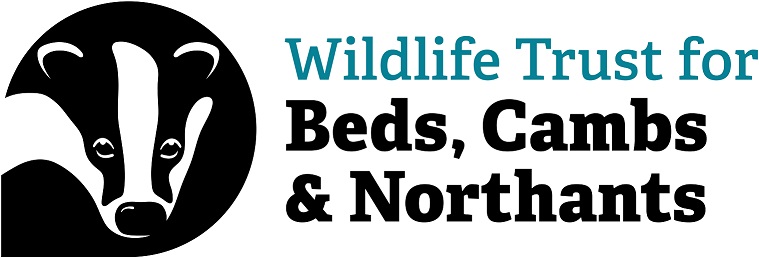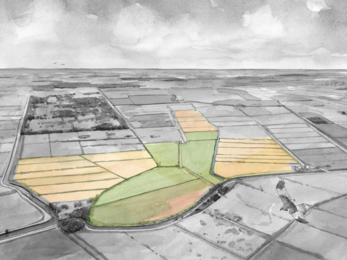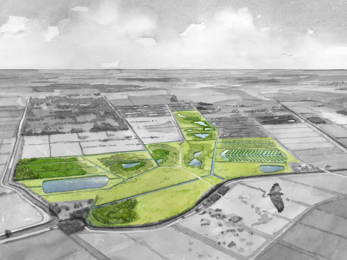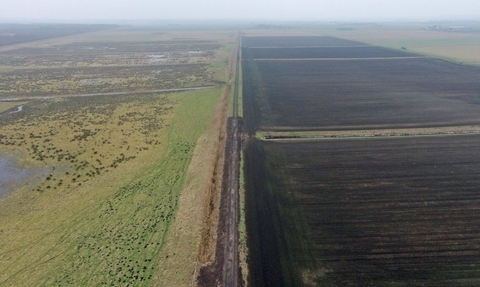
Credit: Henry Stanier
Great Fen Speechly’s Farm registered with Wilder Carbon Standard
Overview
Our Wildlife Trust needs to secure long-term, sustainable income to manage and maintain Speechly’s Farm beyond the lifespan of the resourcing that has kickstarted this project, thanks to National Lottery Heritage Fund (NLHF) and others. Speechly’s Farm business plan includes carbon finance as a way of addressing this. Speechly’s Farm is now registered and has been independently validated for sale of carbon credits under the Wilder Carbon Standard. This will help to ensure that the restored fenland and its numerous habitats will flourish, securing benefits for biodiversity, local communities and remove carbon emissions, helping to address the climate crisis.
Our Trust has chosen the Wilder Carbon Standard for its high value, conservation grade Carbon Standard, quality, and integrity. Speechly’s is the first UK fenland peat project to be registered and fully validated under the Wilder Carbon Standard.
We are delighted to be a Trusted Deliverer. Tackling the climate crisis through carbon storage has been central to the Great Fen since its inception, and it seems fitting that it is the first lowland Fen project to be registered in the UK with Wilder Carbon. We selected Wilder Carbon for its high integrity, ethical standards and highly credible Standards Board and verification partners. Through this exciting project we will be delivering tangible carbon benefits and substantial biodiversity gains simultaneously.CEO Wildlife Trust BCN
What’s next?
Speechly’s Farm carbon will be verified by independent certification body the Soil Association by 2030, and every 5, 10 years after that. We will keep you updated on progress here, through Local Wildlife magazines for our members, and our social media. If you want to know more then please read our FAQs below.
For Companies:
If you’re interested in finding out more about opportunities to purchase carbon credits as part of your commitment to reaching Net Zero, please contact our Business Director via email at corporate@wildlifebcn.org.
Image credits: OHES/Artist John Wolsom
FAQs
Further information about Speechly’s restoration, Wilder Carbon and selling carbon credits.
What’s so special about peat /fenlands? Why is it important to reduce carbon dioxide emissions in these habitats in the UK?
We are facing a climate and biodiversity crisis and it is vital that we need investment in restoring nature now more than ever.
Nature based or natural climate solutions are ways of harnessing what nature does best here in the UK. By storing carbon in the soil and plants and by restoring degraded peatland we can help deliver what is needed to help limit further global warming.
Peatlands exist across less than 3% of the world’s land surface but account for 21% of its soil carbon1.
At Speechly’s, we will be protecting the carbon in the peat soils by raising the water tables as we restore wildlife habitats on the land. For the past two hundred years, farming has drained the peat, then cultivated it with a very low water table, drying out the peat and allowing it to oxidize and release CO2 into the atmosphere. It is estimated that currently emissions from degraded peat on farmlands in Fens contributes to over half of the UK’s entire agricultural CO2 emissions annually2.
1 https://www.unep.org/news-and-stories/story/peatlands-store-twice-much-carbon-all-worlds-forests
2 https://post.parliament.uk/research-briefings/post-pn-0668/
Who and what is Wilder Carbon?
Wilder Carbon’s aim is to restore carbon-rich native habitats across the UK for climate, wildlife, and for society, whilst delivering genuine carbon removals.
Wilder Carbon Ltd is a Not-for-Profit market leader in the high integrity, voluntary nature- based carbon market. First set up by Kent Wildlife Trust, they collectively have decades of experience delivering nature restoration that benefits climate, society, and the economy. Wilder Carbon facilitates projects under its Wilder Carbon Standard and matches these to Approved Buyers.
They have partnered with the Soil Association UK who validate and verify all Wilder Carbon projects. Wilder Carbon manage a high integrity carbon Registry that tracks and displays the progress of the Wilder Carbon projects and the amount of available credits. These are first registered as ‘Estimated Credits’ until the projects and the carbon units available are fully verified by the Soil Association (this is done every 5 then every 10 years over the lifespan of the project).
Why has WTBCN signed up with Wilder Carbon and not, for example, the Peatland Code or Woodland Code, who also run similar schemes for carbon credits in the UK.
Peatland Code and Woodland Code do offer similar schemes for certain UK habitats. However, the Woodland Code is not relevant for lowland peatlands such as the ones we have in the Great Fen. We have chosen Wilder Carbon for its high integrity, high quality Standard, which requires biodiversity recovery as well as the carbon reductions through peatland restoration. One of the key reasons for us choosing Wilder Carbon is that they sell to UK registered businesses that are that are committed to avoiding then reducing their avoidable CO2 emissions and have a public commitment to achieving net zero emissions and they do checks on an annual basis for buyers to retain their ‘approved’ buyer status.
How will you know that companies buying carbon credits aren’t just in it for greenwashing?
Both Wilder Carbon and our Wildlife Trust put all potential buyers through a rigorous due diligence process prior to them being accepted as buyers to purchase credits for the unavoidable emissions. We are assured that Wilder Carbon will only sell to purchasers who are committed to reducing their emissions and it isn’t about greenwashing.
All companies registering as buyers with Wilder Carbon Standard must follow the carbon emissions mitigation hierarchy that requires the following.3
The emissions mitigation hierarchy requires that organisations follow three stages to achieving net zero:
- Avoidance – measures to eliminate activities that produce greenhouse gas emissions
- Reduction – reducing the intensity and extent of emissions from activities that cannot be completely avoided
- Removals – carbon removal measures that offset residual emissions as a last resort once other steps in the hierarchy have taken place
3Wilder Carbon Standard V2 2023.
Can I, as an individual buy carbon credits for WTBCN to support the great work you’re doing on the Great Fen and/or to offset my own travel/energy carbon emissions?
No, we’re afraid not. This Standard is for corporates only. However, we welcome donations from individuals for our work here at WTBCN which will contribute greatly to our impactful work.
You say that you will only work with companies that are committed to reducing the avoidable carbon emissions, so what are you doing as a Trust on this?
We are aware that our work results in operational impacts across our Wildlife Trust (e.g. fleet transport, building energy, procurement, waste, staff commute, business travel, water). To date we have put in place measures to address this through:
- An updated sustainability policy
- Measuring our annual carbon emissions since 2019 to inform priorities on carbon reductions. Assessing our Scope 3 emissions for purchased goods and services (since 2022).
- Sustainability hub for staff – providing guidance and resources for staff (procurement, recycling, transport etc)
- Increased staff capacity – Sustainability Manager and staff-led Sustainability Group
- Action plans resulting in installation of solar panels, transitioning buildings to LED lighting, trial of two electric vans and charging points, staff lift share scheme, procurement guidance, uniform /PPE recycling scheme, energy audits for buildings.
- Funding secured for sustainability initiatives including 4 x Charging Points at HQ, battery operated power tools and solar powered equipment, reducing reliance on fossil fuelled powered tools. The National Heritage Lottery Fund has also supported the purchase of electric all terrain vehicle for our Peatland Progress project at the Great Fen.
- We are committed to reducing our avoidable carbon emissions as much as possible here at WTBCN. We have been working as part of the national movement of Wildlife Trusts to measure our carbon emissions since 2019 and this now includes Scope 1, 2 and Scope 3 emissions for our operations (e.g. energy, fleet, commuting, goods and services etc) as well as our grazing livestock emissions.
As part of the federation of 46 Wildlife Trusts across the country, we are working collectively towards net zero greenhouse gas emissions by 2030.
The methods of estimating emissions from grazing animals (a vital part of our conservation work) are not so well established. There is still much debate, and limited evidence about the grazing and nature-based carbon sequestration. The federation has developed its own tailored Tool to measure emissions for both long- and short-term impacts. Our Trust has been key in providing feedback and advice on the development of this Tool.
We will continue to refine and improve how we measure all this. If you’d like to see more information on how we are part of the wider movement tackling this then please see here: Combatting the climate and nature emergency | The Wildlife Trusts
It is also vital to remember that we are in the midst of a biodiversity crisis as well as a climate crisis so restoring and creating new habitats for wildlife to thrive is crucial. By selecting Wilder Carbon, we will be protecting carbon stocks as well as improving degraded farmlands for flora and fauna to flourish and leading to a positive biodiversity gain. That is not only good for the biodiversity crisis but good for people’s health and wellbeing also.
Is there a rigorous process for monitoring, research and verification (MRV) of the work you’re doing with Wilder Carbon at Speechly’s? How do you know how much carbon emissions you can reduce over such a long period?
We work with a range of institutions including the UK Centre of Ecology and Hydrology (CEH), world leaders in Climate Change science, measuring GHG fluxes with specialist carbon monitoring equipment called ‘flux towers’ at Speechly’s Farm and with world leading experts in soil and carbon at Cranfield University. We also have our own research and monitoring staff and our excellent team of volunteers who carry out extensive flora and fauna surveys for us. There is also a rigorous process for the validation at the start followed by regular ‘verification’ assessments at 5, then every 10 years for the next 50 years. This is carried out by an independent, third party organisation, the Soil Association Certification body who provide a rigorous, robust assessment process to ensure we’re doing what we said we’ll do in terms of the management interventions, restoration as well as verifying that the carbon reductions (represented by units) claimed as being produced from the project can be verified as having actually taken place.
The Wilder Carbon Standard also have a body of external experts who work with them to advise on a number of different technical boards, including External Technical Standards Board and the Monitoring, Research and Verifications Board. Currently, our CEO, is Chair of the latter group in his capacity as a leading expert in climate change and peatlands.
Why are you seeking income generation via Wilder Carbon credits sales when you have secured funding via the National Lottery Heritage Fund and via the Appeal when you were looking to acquire Speechly’s?
Speechly’s Farm is now registered with the Wilder Carbon Standard for carbon credit sales. This, along with NLHF funding, is providing a blended model of finance for the restoration and creation of the wetlands. It will enable us to secure long-term sustainable income to support habitat restoration and ensure its future management, creating biodiverse rich fen habitats at scale. We would not be able to do this with it.
What is the status of the Wilder Carbon credit sales for Speechly's Farm?
As of May 2025, we will be launching Speechly’s Farm carbon credits. This will be marketed by Wilder Carbon and they will be managing the sales of ‘estimated’ carbon credits to companies who have passed both their due diligence assessments as well as our own Trust’s due diligence. Any sales made will be ‘estimated carbon units and these will be fully verified by year 2030, up until that point any companies purchasing carbon units from us won’t be able to claim the carbon removal units as part of their external Environmental, Social and Governance (ESG) reporting.
Are other Wildlife Trusts working with Wilder Carbon?
Yes, a number of other Trusts have signed up to the Wilder Carbon scheme including Somerset Wildlife Trust’s HoneyGar Farm and Kent Wildlife’s Trust’s Heather Corrie Vale. Other Wildlife Trusts have been approved as ‘Trusted Delivers’ as well as other organisations, so further projects will be coming on line under the Wilder Carbon Scheme over time.
What do the following terms mean? I get confused between emissions, lock-up, carbon capture and carbon sequestration.
Carbon reduction – this is usually referred to in relation to where companies are taking actions to ‘reduce’ their ‘avoidable’ emissions from their operations such as fleet transport, building energy, staff commuting etc.
Carbon removal (you may also see it referred to as ‘avoided’ carbon emissions) - for example restoration of degraded peatland (which emits more carbon than peatlands in a near-natural/natural state) to near-natural peatland habitat (which emits less carbon than degraded peatlands), thereby ‘avoiding’ those emissions taking place.3
Over time we will be removing carbon emissions from Speechly’s as the land is restored from degraded arable peatlands to near natural states.
Carbon lock-up – this leads to carbon being stored in a given habitat type (such as in trees and other vegetation).3
Carbon sequestration - the capturing, removal and storage of carbon dioxide (CO2) from the earth’s atmosphere, usually by plants and trees3.
Carbon capture – this is usually referred to technologies that are harnessed to remove CO2 emissions from the atmosphere rather than nature based solutions.
3Wilder Carbon Standard V2 2023.
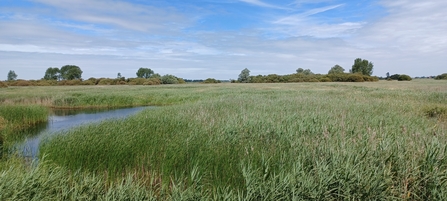
Reeds at the Great Fen by Henry Stanier
